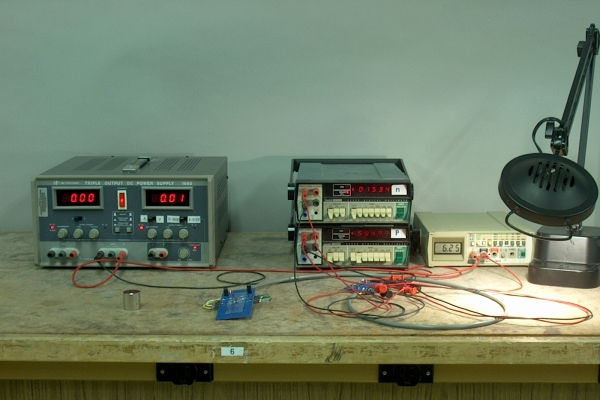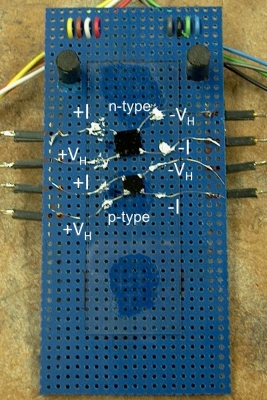
Thanks to a request from Prof. Don Marolf, and work by Bo Shojaei, in Prof. Chris Palmstrøm’s group, and Prof. Jim Allen, for this version of the Hall effect demonstration
At the heart of this demonstration are two small wafers of semi-insulating GaAs, one having a 1-micron-thick layer of Si-doped GaAs (n-type), and one having a 2-micron-thick layer of unintentionally-doped GaSb. (p-type – It is “unintentionally” doped, because its positive charge carriers come from defects that occur naturally as it is being made.) These are shown below:

The two samples are wired in parallel, with a resistor in series with the one having the lower resistance, so that they draw equal current from a single power supply. Pins on the board at the other end of the cable allow for easy connection of the current supply and two voltmeters to measure the two Hall voltages. Because it is preferable to limit the current to a magnitude that is below what the meter on the power supply can indicate (on the order of 2 or 3 mA through each device, for a total current of 4-6 mA), an external ammeter, at right in the photograph, is connected in series with the samples. The two meters to its left show the Hall voltages. A video camera allows projection of all three readouts simultaneously. For the magnetic field, you can use the rare-earth magnet shown in the photograph (the cylinder in front of the power supply), or you can use the electromagnet shown in the photograph on the page for demonstration 68.57 -- Hall effect. The board that carries the semiconductor samples is protected on each side by an acetate sheet, so that it can be safely inserted between the pole faces of the magnet.
You can download a .pdf file of the above image here to show the class, so that the students can see what the samples look like, and the directions of the current, the Hall voltage measurement and the magnetic field. Both samples exhibit a Hall voltage at zero field. For the n-type material, with a current of ~3 mA and a magnetic field of about 0.44 T, the change in Hall voltage (from zero field to 0.44 T in either direction) is much greater than this offset. For the p-type material, however, the offset is a little greater than twice the change in Hall voltage. A file that contains further details about the samples, and a set of typical measurements, is located here.
When one places a current-carrying conductor in a magnetic field (perpendicular to the plane of the conductor), the charge carriers suffer a sideways force, F, equal to qvd × B, where q is the charge on each charge carrier, vd is the drift velocity of the charge carriers (given by j/ne, where j is the current density (in amperes/unit area cross-section), n is the number of charge carriers per unit volume, and e is the charge per carrier; see demonstration 64.15 -- Resistance simulator) and B is the magnetic field (in Tesla). Since oppositely charged carriers have opposite drift velocities, for a given direction of current flow and magnetic field orientation, this sideways force is in the same direction regardless of the sign of the charge carriers (because the sign change for the charge and the sign change for the drift velocity cancel each other).
If we consider a pair of points x and y opposite each other at each edge of the strip, so that F pushes the charges from point x to point y, this sideways drift of charges produces a potential difference between x and y, the Hall potential difference, which we can denote Vxy. This is the potential difference that the voltmeter measures in this demonstration. The sign of the charge carriers determines the sign of Vxy. If the charge carriers are positive, y ends up at a higher potential than x; if they are negative, then y is at a lower potential than x. This potential difference also produces a transverse Hall electric field, EH = Vxy/d, where d is the width of the conductor (or the distance between x and y). This electric field opposes the sideways drift of the charge carriers until a point of equilibrium is reached where it just cancels the sideways magnetic deflecting force and qEH + qvd × B = 0, or EH = -vd × B. If we measure EH and B, we can find both the magnitude and direction of vd. If the direction is parallel to the current flow, the charge carriers are positive; if it is antiparallel to the current flow, the charge carriers are negative. These phenomena, and the effect in general, are named for Edwin H. Hall, who discovered them in 1879 American Journal of Mathematics, Vol. 2, No. 3 (Sep., 1879), pp. 287-292).
It is also possible to calculate the density of charge carriers by means of the Hall effect. When the drift velocity and the magnetic field are at right angles, their magnitudes and that of the Hall electric field are related by EH = vdB. If we substitute j/ne for vd, we get EH = (j/ne)B, or n = jB/eEH. We measure Vxy (or VH, as it is labeled in the photograph of the GaAs wafers), which equals EH/w, if we call the cross-wise dimension w. The area is wd, where d is the thickness of the layer. So VH = iB/ned, or n = iB/edVH.
This holds well for monovalent metals. The free-electron model on which the above analysis is based, however, fails for nonmonovalent metals, iron and similar magnetic materials, and for semiconductors such as germanium. (All the devices in this demonstration are semiconductors.) For such materials, one must use a quantum mechanical model to obtain an accurate calculation. Depending on the material and the doping level, however, one may be able to obtain a reasonable estimate.
References:
1) David Halliday and Robert Resnick. Physics, Part Two, Third Edition (New York: John Wiley and Sons, Inc., 1978), pp. 728-730.